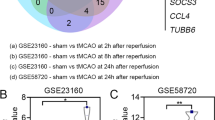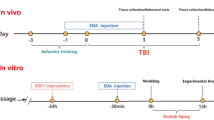Abstract
Intracerebral hemorrhage (ICH) is a serious medical problem, and effective treatment is limited. Hemorrhaged blood is highly toxic to the brain, and heme, which is mainly released from hemoglobin, plays a vital role in neurotoxicity. However, the specific mechanism involved in heme-mediated neurotoxicity has not been well studied. In this study, we investigated the neurotoxicity of heme in neurons. Neurons were treated with heme, and cell death, autophagy, and endoplasmic reticulum (ER) stress were analyzed. In addition, the relationship between autophagy and apoptosis in heme-induced cell death and the downstream effects were also assessed. We showed that heme induced cell death and autophagy in neurons. The suppression of autophagy using either pharmacological inhibitors (3-methyladenine) or RNA interference of essential autophagy genes (BECN1 and ATG5) decreased heme-induced cell death in neurons. Moreover, the ER stress activator thapsigargin increased cell autophagy and the cell death ratio following heme treatment. Autophagy promoted heme-induced cell apoptosis and cell death through the BECN1/ATG5 pathway. Our findings suggest that heme potentiates neuronal autophagy via ER stress, which in turn induces cell death via the BECN1/ATG5 pathway. Targeting ER stress-mediated autophagy might be a promising therapeutic strategy for ICH.





Similar content being viewed by others
Abbreviations
- 3-MA:
-
3-methyladenine
- AO:
-
acridine orange
- ATF4:
-
activating transcription factor 4
- CASP3:
-
caspase 3, apoptosis-related cysteine peptidase
- ER:
-
endoplasmic reticulum
- DDIT3:
-
DNA-damage-inducible transcript 3
- DMSO:
-
dimethyl sulfoxide
- FACS:
-
fluorescence activated cell sorting
- ICH:
-
Intracerebral hemorrhage
- LC3B:
-
microtubule-associated protein 1 light chain 3 beta
- MDC:
-
monodansylcadaverine
- PARP1:
-
poly (ADP-ribose) polymerase 1
- PI:
-
propidium iodide
- Thap:
-
thapsigargin
- TEM:
-
transmission electron microscopy
- Z-VAD:
-
Z-VAD-FMK
References
Bao Y, Pu Y, Yu X, Gregory BD, Srivastava R, Howell SH, Bassham DC (2018) IRE1B degrades RNAs encoding proteins that interfere with the induction of autophagy by ER stress in Arabidopsis thaliana. Autophagy. 14:1562–1573. https://doi.org/10.1080/15548627.2018.1462426
Benito-Cuesta I, Diez H, Ordonez L, Wandosell F (2017) Assessment of autophagy in neurons and brain tissue. Cells 6. https://doi.org/10.3390/cells6030025
Bishop GM, Robinson SR (2001) Quantitative analysis of cell death and ferritin expression in response to cortical iron: implications for hypoxia-ischemia and stroke. Brain Res 907:175–187 doi: https://doi.org/10.1016/s0006-8993(01)02303-4
Caliaperumal J, Wowk S, Jones S, Ma Y, Colbourne F (2013) Bipyridine, an iron chelator, does not lessen intracerebral iron-induced damage or improve outcome after intracerebral hemorrhagic stroke in rats. Transl Stroke Res 4:719–728. https://doi.org/10.1007/s12975-013-0272-3
Chen Y, Scarcelli V, Legouis R (2017) Approaches for studying autophagy in Caenorhabditis elegans. Cells 6. https://doi.org/10.3390/cells6030027
Chen-Roetling J, Sinanan J, Regan RF (2012) Effect of iron chelators on methemoglobin and thrombin preconditioning. Transl Stroke Res 3:452–459. https://doi.org/10.1007/s12975-012-0195-4
Conte A et al (2017) High mobility group A1 protein modulates autophagy in cancer cells. Cell Death Differ 24:1948–1962. https://doi.org/10.1038/cdd.2017.117
Duan X, Wen Z, Shen H, Shen M, Chen G (2016) Intracerebral hemorrhage, oxidative stress, and antioxidant therapy. Oxidative Med Cell Longev 2016:1203285. https://doi.org/10.1155/2016/1203285
Duan XC et al (2017) Roles of autophagy and endoplasmic reticulum stress in intracerebral hemorrhage-induced secondary brain injury in rats. CNS Neurosci Ther 23:554–566. https://doi.org/10.1111/cns.12703
Elander PH, Minina EA, Bozhkov PV (2018) Autophagy in turnover of lipid stores: trans-kingdom comparison. J Exp Bot 69:1301–1311. https://doi.org/10.1093/jxb/erx433
Gall T et al (2018) Heme induces endoplasmic reticulum stress (HIER stress) in human aortic smooth muscle cells. Front Physiol 9:1595. https://doi.org/10.3389/fphys.2018.01595
Gall T, Balla G, Balla J (2019) Heme, heme oxygenase, and endoplasmic reticulum stress-a new insight into the pathophysiology of vascular diseases. Int J Mol Sci 20. https://doi.org/10.3390/ijms20153675
Galluzzi L, Bravo-San Pedro JM, Demaria S, Formenti SC, Kroemer G (2017) Activating autophagy to potentiate immunogenic chemotherapy and radiation therapy. Nat Rev Clin Oncol 14:247–258. https://doi.org/10.1038/nrclinonc.2016.183
Geronimo-Olvera C, Montiel T, Rincon-Heredia R, Castro-Obregon S, Massieu L (2017) Autophagy fails to prevent glucose deprivation/glucose reintroduction-induced neuronal death due to calpain-mediated lysosomal dysfunction in cortical neurons. Cell Death Dis 8:e2911. https://doi.org/10.1038/cddis.2017.299
Gyongyosi A et al (2019) Inhibited autophagy may contribute to heme toxicity in cardiomyoblast cells. Biochem Biophys Res Commun 511:732–738. https://doi.org/10.1016/j.bbrc.2019.02.140
Han Y et al (2018) Role of autophagy in breast cancer and breast cancer stem cells (review). Int J Oncol 52:1057–1070. https://doi.org/10.3892/ijo.2018.4270
Hua Y, Keep RF, Hoff JT, Xi G (2008) Deferoxamine therapy for intracerebral hemorrhage. Acta Neurochir Suppl 105:3–6. https://doi.org/10.1007/978-3-211-09469-3_1
Ishikawa Y, Holden P, Bachinger HP (2017) Heat shock protein 47 and 65-kDa FK506-binding protein weakly but synergistically interact during collagen folding in the endoplasmic reticulum. J Biol Chem 292:17216–17224. https://doi.org/10.1074/jbc.M117.802298
Jin S, Wei J, You L, Liu H, Qian W (2018) Autophagy regulation and its dual role in blood cancers: a novel target for therapeutic development (review). Oncol Rep 39:2473–2481. https://doi.org/10.3892/or.2018.6370
Khatri R, Afzal MR, Qureshi MA, Maud A, Huanyu D, Jose Rodriguez G (2019) Pre-existing renal failure increases in-hospital mortality in patients with intracerebral hemorrhage. J Stroke Cerebrovasc Dis 28:237–242. https://doi.org/10.1016/j.jstrokecerebrovasdis.2018.07.036
Kwon KJ et al (2013) Neuroprotective effects of valproic acid against hemin toxicity: possible involvement of the down-regulation of heme oxygenase-1 by regulating ubiquitin-proteasomal pathway. Neurochem Int 62:240–250. https://doi.org/10.1016/j.neuint.2012.12.019
Kwon SK et al (2015) Nafamostat mesilate attenuates transient focal ischemia/reperfusion-induced brain injury via the inhibition of endoplasmic reticulum stress. Brain Res 1627:12–20. https://doi.org/10.1016/j.brainres.2015.09.013
Lakovic K et al (2014) Bilirubin and its oxidation products damage brain white matter. J Cereb Blood Flow Metab 34:1837–1847. https://doi.org/10.1038/jcbfm.2014.154
Lalaoui N, Lindqvist LM, Sandow JJ, Ekert PG (2015) The molecular relationships between apoptosis, autophagy and necroptosis. Semin Cell Dev Biol 39:63–69. https://doi.org/10.1016/j.semcdb.2015.02.003
Lambelet M, Terra LF, Fukaya M, Meyerovich K, Labriola L, Cardozo AK, Allagnat F (2018) Dysfunctional autophagy following exposure to pro-inflammatory cytokines contributes to pancreatic beta-cell apoptosis. Cell Death Dis 9:96. https://doi.org/10.1038/s41419-017-0121-5
Marion J, Le Bars R, Besse L, Batoko H, Satiat-Jeunemaitre B (2018) Multiscale and multimodal approaches to study autophagy in model plants. Cells 7. https://doi.org/10.3390/cells7010005
Marshall RS, Vierstra RD (2018) Autophagy: the master of bulk and selective recycling. Annu Rev Plant Biol 69:173–208. https://doi.org/10.1146/annurev-arplant-042817-040606
Nazim UM, Jeong JK, Seol JW, Hur J, Eo SK, Lee JH, Park SY (2015) Inhibition of the autophagy flux by gingerol enhances TRAIL-induced tumor cell death. Oncol Rep 33:2331–2336. https://doi.org/10.3892/or.2015.3869
Niu M, Dai X, Zou W, Yu X, Teng W, Chen Q, Sun X, Yu W, Ma H, Liu P (2017) Autophagy, endoplasmic reticulum stress and the unfolded protein response in intracerebral hemorrhage. Transl Neurosci 8:37–48. https://doi.org/10.1515/tnsci-2017-0008
Payabvash S, Noorbaloochi S, Qureshi AI (2017) Topographic assessment of acute ischemic changes for prognostication of anterior circulation. Stroke J Neuroimaging 27:227–231. https://doi.org/10.1111/jon.12383
Rieusset J (2018) The role of endoplasmic reticulum-mitochondria contact sites in the control of glucose homeostasis: an update. Cell Death Dis 9:388. https://doi.org/10.1038/s41419-018-0416-1
Roest G, Hesemans E, Welkenhuyzen K, Luyten T, Engedal N, Bultynck G, Parys JB (2018) The ER stress inducer l-azetidine-2-carboxylic acid elevates the levels of phospho-eIF2alpha and of LC3-II in a Ca(2+)-dependent manner. Cells 7. https://doi.org/10.3390/cells7120239
Sennfalt S, Norrving B, Petersson J, Ullberg T (2018) Long-term survival and function after stroke. Stroke:STROKEAHA118022913 doi:https://doi.org/10.1161/STROKEAHA.118.022913
Shen J, Liu Y, Song Y, Li L, Duan C, Zhou Y, Ke K (2015) CHMP4B, ESCRT-III associating protein, associated with neuronal apoptosis following intracerebral hemorrhage. Brain Res 1597:1–13. https://doi.org/10.1016/j.brainres.2014.11.043
Shen X et al (2016) Autophagy regulates intracerebral hemorrhage induced neural damage via apoptosis and NF-kappaB pathway. Neurochem Int 96:100–112. https://doi.org/10.1016/j.neuint.2016.03.004
Shi H, Wang J, Huang Z, Yang Z (2018) IL-17A induces autophagy and promotes microglial neuroinflammation through ATG5 and ATG7 in intracerebral hemorrhage. J Neuroimmunol 323:143–151. https://doi.org/10.1016/j.jneuroim.2017.07.015
Sipila JO, Ruuskanen JO, Kauko T, Rautava P, Kyto V (2017) Seasonality of stroke in Finland. Ann Med 49:310–318. https://doi.org/10.1080/07853890.2016.1254350
Stavoe AKH, Holzbaur ELF (2019) Axonal autophagy: mini-review for autophagy in the CNS. Neurosci Lett 697:17–23. https://doi.org/10.1016/j.neulet.2018.03.025
Takeuchi S et al (2013) Evaluation of the stage of hemorrhage using optical diffuse reflectance spectroscopy: an in vivo study. Acta Neurochir Suppl 118:45–48. https://doi.org/10.1007/978-3-7091-1434-6_7
Tian Y, Kuo CF, Sir D, Wang L, Govindarajan S, Petrovic LM, Ou JH (2015) Autophagy inhibits oxidative stress and tumor suppressors to exert its dual effect on hepatocarcinogenesis. Cell Death Differ 22:1025–1034. https://doi.org/10.1038/cdd.2014.201
Travassos LH, Vasconcellos LR, Bozza MT, Carneiro LA (2017) Heme and iron induce protein aggregation. Autophagy 13:625–626. https://doi.org/10.1080/15548627.2016.1271515
Tschurtschenthaler M et al (2017) Defective ATG16L1-mediated removal of IRE1alpha drives Crohn’s disease-like ileitis. J Exp Med 214:401–422. https://doi.org/10.1084/jem.20160791
Ushioda R et al (2016) Redox-assisted regulation of Ca2+ homeostasis in the endoplasmic reticulum by disulfide reductase ERdj5. Proc Natl Acad Sci U S A 113:E6055–E6063. https://doi.org/10.1073/pnas.1605818113
Vasconcellos LR et al (2016) Protein aggregation as a cellular response to oxidative stress induced by heme and iron. Proc Natl Acad Sci U S A 113:E7474–E7482. https://doi.org/10.1073/pnas.1608928113
Warri A et al (2018) Autophagy and unfolded protein response (UPR) regulate mammary gland involution by restraining apoptosis-driven irreversible changes. Cell Death Dis 4:40. https://doi.org/10.1038/s41420-018-0105-y105
Wu J, Hua Y, Keep RF, Nakamura T, Hoff JT, Xi G (2003) Iron and iron-handling proteins in the brain after intracerebral hemorrhage. Stroke 34:2964–2969. https://doi.org/10.1161/01.STR.0000103140.52838.45
Wu MY, Song JX, Wang SF, Cai CZ, Li M, Lu JH (2018) Selective autophagy: the new player in the fight against neurodegenerative diseases? Brain Res Bull 137:79–90. https://doi.org/10.1016/j.brainresbull.2017.11.009
Xue Y et al (2017) Endoplasmic reticulum-mitochondria junction is required for iron homeostasis. J Biol Chem 292:13197–13204. https://doi.org/10.1074/jbc.M117.784249
Yi MC, Melkonian AV, Ousey JA, Khosla C (2018) Endoplasmic reticulum-resident protein 57 (ERp57) oxidatively inactivates human transglutaminase 2. J Biol Chem 293:2640-2649 https://doi.org/10.1074/jbc.RA117.001382
Yu Z, Zheng J, Guo R, Ma L, You C, Li H (2019) Prognostic significance of leukoaraiosis in intracerebral hemorrhage: a meta-analysis. J Neurol Sci 397:34–41. https://doi.org/10.1016/j.jns.2018.12.022
Zhang R, Ji R, Pan Y, Jiang Y, Liu G, Wang Y (2017) External validation of the prestroke independence, sex, age, National Institutes of Health Stroke Scale Score for predicting pneumonia after stroke using data from the China National Stroke Registry. J Stroke Cerebrovasc Dis 26:938–943. https://doi.org/10.1016/j.jstrokecerebrovasdis.2016.10.043
Funding
The study was supported by Natural Science Foundation of Yongchuan district of Chongqing (Ycstc, 2019nb02026) and Chongqing Health Committee (2015msxm061).
Author information
Authors and Affiliations
Contributions
Conceptualization: ZY; methodology: BT, and NZ; manuscript preparation: NJ. All authors read and approved the final manuscript.
Corresponding authors
Ethics declarations
Competing Interests
The authors declare that they have no competing interests.
Ethics Approval
All procedures and experiments were conducted in accordance with the guidelines established by the Principles of Laboratory Animal Care and National standards. All protocols were approved by the institutional ethics committees of Zhejiang University School of Medicine (approval number SYXK-2018-0012).
Consent for Publication
Not applicable.
Additional information
Publisher’s Note
Springer Nature remains neutral with regard to jurisdictional claims in published maps and institutional affiliations.
Rights and permissions
About this article
Cite this article
Yang, Z., Zhou, C., Shi, H. et al. Heme Induces BECN1/ATG5-Mediated Autophagic Cell Death via ER Stress in Neurons. Neurotox Res 38, 1037–1048 (2020). https://doi.org/10.1007/s12640-020-00275-0
Received:
Revised:
Accepted:
Published:
Issue Date:
DOI: https://doi.org/10.1007/s12640-020-00275-0




